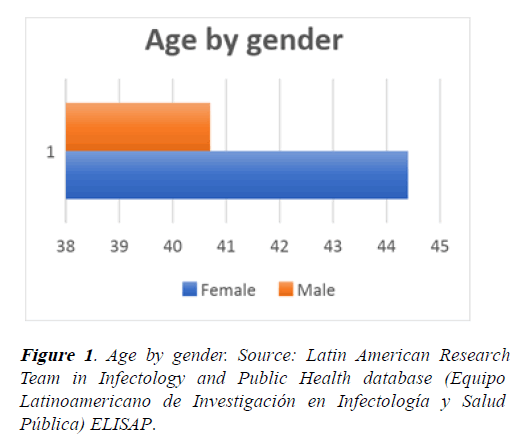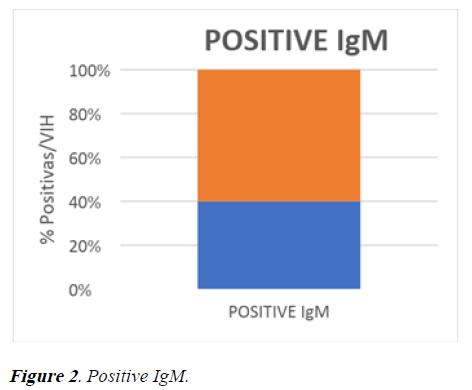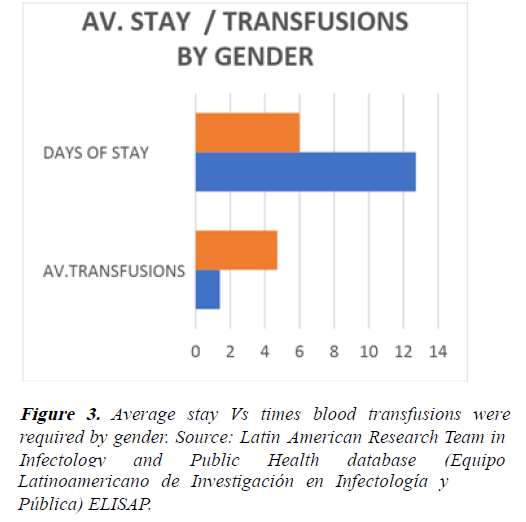Research Article - Hematology and Blood Disorders (2021) Volume 4, Issue 4
Clinical and seroepidemiological description and observations of pure red cell aplasia secondary to parvovirus B19 infection in HIV -positive patients in a third hospital level in Colombia.
Larry Luber Martinez Rosado1*, Leidy Carolina Rico2
1Department of infectology, Latin American Research Team in Infectology and Public Health (ELISAP), Medellin, Colombia
2Department of infection prevention and control committee, La Maria Hospital, Medellin, Colombia
- Corresponding Author:
- Larry Luber Martinez Rosado Department of infectology La Maria Hospital
Medellin
Colombia
E-mail: 18lubermed22@gmail.com
Accepted date: 24 August, 2021
Citation: LLM Rosado, LC Rico. Clinical and seroepidemiological description and observations of pure red cell aplasia secondary to parvovirus B19 infection in HIV positive patients in a third hospital level in Colombia. Hematol Blood Disord 2021;4(4):1-4.
Abstract
Parvovirus B19 is a global infection that can cause serious and life threatening disorders in susceptible patient groups. Viruses of the family Parvoviridae (Latin parvum [meaning small or tiny]), are among the smallest viruses described, 18?28 nm in diameter. There are 2 subfamilies of the family Parvoviridae and Densovirina (Latin denso [thick or compact]). Parvovirinae may infect humans,but Densovirina infect only arthropods. Structurally, these viruses are non-enveloped, icosahedral viruses that contain a single-stranded linear DNA genome. The small size of these viruses mightaccount for their late discovery. In 1974, the first pathogenic human parvovirus was discovered and named B19 from the coding of a serum sample, number 19 in panel B, which gave anomalous results during testing for hepatitis B. Parvovirus B19, genotype 1, has a worldwide distribution. Genotypes 2 and 3 tend to be found in Europe and Africa. We present the clinical and seroepidemiological description of cases of aplasia of the red serie without affecting hematimetric indices in HIV positive patients with positive serology to Parvovirus B19 admitted to the hospitalization service in the period from April 2016 to April 2017.Keywords
DNA, Parvovirus, viruses, genome.
Introduction
Parvovirus B19 is a little, nonenveloped, single-abandoned DNA infection, normally contaminating small kids. The frequency of intense essential parvovirus B19 contamination in liable women during pregnancy is low. Parvovirus B19 is sent through contact to tainted respiratory beads or blood components, and in an upward direction, from mother to hatchling. Conditions related with parvovirus B19 contamination: erythema infectiosum, arthropathy, transient aplastic emergency, unadulterated red platelet aplasia, and fetal infection. Since the revelation of B19 infection in 1975, a wide assortment of blood sicknesses and cytopenias influencing a few platelet genealogies have been archived during or following B19 disease. These incorporate cytopenias influencing the erythroid, megakaryoblastoid, myeloid and lymphoid heredities, just as an assortment of bicytopenias, pancytopenia, bone marrow rot/fat embolism condition, myelodysplastic disorder, leucoerythroblastopenia, and hemophagocytic lymphohistiocytosis. B19 disease may likewise muddle and go before the course of intense leukemia, the meaning of which still needs not really set in stone [1-3].
Methodology
This retrospective descriptive study included the period from April 2016 to April 2017, in the Infectious Diseases Unit of La María Hospital in Medellín, Colombia. Patients older than 15 years previously diagnosed with HIV who presented parameters of aplasia of the red series without affecting blood counts, discarding other causes of anemia and confirmations of the serological pair (IgG and IgM) positive for Parvovirus B19 were included. Study variables.
This study variables were epidemiological (age, gender, HIV infection); clinical (hospitalization period, average of transfusions, stay days, stay day cost, other coinfections); paraclinical (inmunglobulins G and M levels, HIV plasma load, TCD4 lymphocyte level), cytochemistry (hemoglobin, hematocrit).
Results
A total of 16 cases were documented, 11 men (69%) and 5 women (31%) with an average age of 40.7 and 44.4 years respectively (Figure 1) 5 of the 16 patients (31.25%) had positive IgM levels (distributed among 3 men and 2 women) without IgG activity documented in the same sample, (Figure 2) and 4 of these 5 patients were without treatment for their HIV (80%), the average in grams per deciliter of hemoglobin and hematocrit at the time of sampling was 8.92 g/dl and 28.6 g/dl respectively. Draws attention the most prevalent opportunist in our sampling is mycobacterium tuberculosis with 5 cases (31%) distributed in 4 men and 1 woman. Most likely this association is based on their immunosuppression status, but the immunological bases of this possible asociation must be studied.
Latinoamericano de Investigación en Infectología y Salud Pública) ELISAP.
All the patients included in our study had IgG titles but only 6 had positive titles with a positive reference value> 11 (37.5%). The average of CD4 cell count was 115 for the male population and 187.2 for the female population. (Figure 3) All our patients required transfusions of units of compatible red blood cells in the range of 1.4 and 4.7 times, for women and men respectively; paradoxically finding longer stays (12.72 Vs 6 days) in the first group with an average stay in days of 10.6 and a cost impact of US $ 2,198.
Regarding sexual orientation, 5 or 31.25% of our patients were men who have sex with men (MSM), of which 2 had demonstrated IgM activity in the samples analyzed.
Discussion
The B19 infection has different clinical nuances and should be considered in any case of nonimmune hydrops, approximately 30-50% of pregnant women are nonimmune to the virus [4]. There are sufficient lines of evidence in the literature that state that Parvovirus B19 infection can be associated with the development of acute hepatitis due to direct cytopathic and indirect immunological injury through CD8+ cytotoxic T cells, [5] and it’s also registred acute parvovirus B19 associated myocarditis [6].
In our observation, draws attention the most prevalent opportunist in the sampling is mycobacterium tuberculosis, with 5 cases distributed in 4 men and woman; which invites us to deepen some type of predisposition to the complex in patients with a clearly disturbed immunity; or responces to our kind of poblation. There is not scientific registers about this asociation.
A total of 99 HIV infected patients with mean age of 37.9_10 year and 64 healthy controls with mean age of 39.9_12.4 year were enrolled in an Iranian study. The prevalence of B19 IgG and IgM in healthy control group was 25% (16 of 64) B19 DNA found in 9.4% (6 of 64) of this group. The rate of B19 viremia in HIV patients without IgG was 10.1%, and the mean of their CD4 was 440.5_266.16 cells/mm. [7]. All the patients included in our study (16) had IgG titles and of these only 6 had positive titles with a positive reference value> 11 (37.5%) presenting on average a CD4 cell count of 115 for the male population and 187.2 for the female population (Figure 3).
In the data demonstrated by a chinese group, exist relatively high prevalence of B19V in plasma samples. Therefore, to reduce the risk of B19V transmission, the implementation of B19V NAT assays capable of detecting all B19V genotypes and discard donations with high titer B19V DNA for Chinese blood products manufacturers seems to be necessary for blood safety. [8] The high level of B19V in plasma samples could present a great risk in plasma derivatives; therefore donants must be investigated in our country. All the patients required transfusions of units of compatible red blood cells, impacting the days of stay, costs and other clinical intercurrences
A study realiced in Taiwan focused in investigate the associations between B-19 and HIV-1 among men who have sex with men (MSM) and injection drug users (IDUs) patients. IDUs had 6.74 times higher odds of being infected with B19 than MSM. In that study the prevalence of anti- B19 antibodies was almost the same between HIV-1- seropositive and HIV-1- seronegative subjects. In our observation, regarding sexual orientation, we found about the 16 patients included, 5 were men who have sex with men (MSM) (31.25%), of which 2 had demonstrated IgM activity in the samples analyzed [9]. Another 6 were men who had sex with women (MSW) and another 5 were women for the total of 16 samples analyzed.
In a study of 31 samples analyzed in a South American study, the circulation of genotype 1a was demonstrated in Argentina. In Colombia, the circulating variable, the risk factors, the impact, on costs and the relationship between the CD4 cut-off point and the risk of being infected with Parvovirus B 19 are unknown [10].
Acute parvovirus B19 (B19V) infection is characterized by high-level viremia. Antibodies against the capsid proteins VP1 and VP2 may complex with B19V-particles thereby becoming undetectable in diagnostic tests. Only the combination of assays for detection of B19V-DNA and antibodies enables correct diagnosis [11]. Therefore, its pertinent a deep molecular investigation to define real implications, epidemiology and distribution of this agent in our country [12-16].
Conclusion
Parvovirus B19 is a global infection that can cause serious and life threatening disorders in susceptible patient groups. Persistent parvovirus B19 infections in human immunodeficiency virus type 1 infected patients have been reported. The two viruses could share common target cells. The co-infection by Parvovirus B19 is associated with longer days of hospital stay, costs and complications such as nosocomial infections and need of multiple transfusions. There is an association between the absence of HIV treatment and coinfection with Parvovirus B19. But, as for other infectious opportunists, the cut-off point of CD4 cells must be defined toinclude Parvovirus B19 in the patient's initial management algorithm, or failing that; be able to economize diagnostic resources in front of a patient with protective CD4 levels regarding this virus.
Draws attention the most prevalent opportunist infection in the sampling is Mycobacterium tuberculosis (MTB). Presumably due to the psychosocial conditions of our target population (street people, HIV, drug addicts) but we must study whether there is an immunological background or the pathophysiology of the Parvovirus B19 infection that supports this probable association.
By the other side, B19 transmission by cellular blood products correlates with the virus concentration and the concentration of neutralizing antibodies. In Chile, IgG seroprevalence was demonstrated up to 55% in the infant donor population and B19 genomic DNA was found in 26 of 573 (4.5%) HIVpositive individuals, a higher prevalence than in blood donors. So its pertinent demonstrates the persistence of B19 in the circulation of both immunocompetent and immunocompromised subjects, with implications for blood safety. As well as identifying and characterizing the serotype of parvovirus B19 that circulates, infects and complicates patients with HIV seropositive in Colombia.
References
- Bernstein D, Sahly H, Keitel W, et al. Safety and immunogenicity of a candidate parvovirus B19. Vaccine. 2011; 29(43): 7357–7363.
- Fonseca E. Etymologia: Parvovirus. Emerg Infect Dis. 2018; 24(2): 291-293.
- Stanley J. 8th ed Manual of molecular and clinical laboratory immunology
- Lamont RF, Sobel JD, Vaisbuch E, et al. Parvovirus B19 infection in human pregnancy. BJOG. 2011; 118(2): 175-186.
- Bihari C, Rastogi A, Saxena P, et al. Parvovirus b19 associated hepatitis. Hepat Res Treat. 2013; 472027.
- Bock CT, Klingel K, Kandolf R. Human parvovirus B19-associated myocarditis. N Engl J Med. 2010; 362(13): 1248‐1249.
- Nouri, M, Kamakifar P, Khodabandehlou N, et al. Association between parvovirus B19 and anemia in HIV-infected patients. Med J Islam Repub Iran. 2019; 33: 137
- Jia J, Ma Y, Zhao X, et al. Prevalence of human parvovirus B19 in Chinese plasma pools for manufacturing plasma derivatives. Virol J. 2015; 12: 162.
- Yuan-Ming L, Shao-Yuan, Chuang, et al. Epidemiology of human herpesvirus type 8 and parvovirus B19 infections and their association with HIV-1 among men who have sex with men and injection drug users in Taiwan. J Microbiol Immunol Infect. 2013; 47(3): 233-238.
- Marengo JM. Epidemiología molecular de parvovirus humano B19 en Argentina. 2017.
- Bredl S. False-negative serology in patients with acute parvovirus B19 infection. J Clin Virol, 2011; 51(2): 115-120.
- Heegaard E D, Brown K E. Human parvovirus B19. Clin Microbiol Rev. 2002; 15(3): 485–505.
- Gaggero A, Rivera J ,Calquín E, et al. Seroprevalence of IgG antibodies against parvovirus B19 among blood donors from Santiago, Chile. Rev Méd Chile 2007; 135: 443-448.
- He M, Zhu J, Yin H, et al. Human immunodeficiency virus/human parvovirus B19 co-infection in blood donors and AIDS patients in Sichuan, China. Blood Transfus.2012; 10: 502-514.


